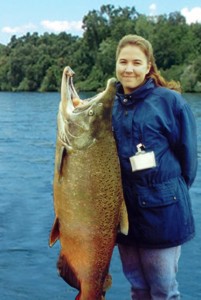|
Martha Volkoff
|
![[Go to CSUS Home Page]](gifs/csus_logo.jpg)
|
|
Martha Volkoff
|
![[Go to CSUS Home Page]](gifs/csus_logo.jpg)
|

Stock Discrimination of Central Valley Chinook Salmon using Otolith Microstructure.
ABSTRACT
The Central Valley, California watershed supports a diverse, but declining, metapopulation of Chinook salmon. Chinook salmon spawn in numerous tributaries of the system and the resultant offspring migrate from these tributaries to the Pacific Ocean, commingling in the lower rivers and the Sacramento-San Joaquin Delta, coincident with the focus of water management activities and where tracking of individual stocks is important.
I examined the utility of otolith microstructure analysis as a means of discriminating between stocks of Central Valley Chinook salmon. Otolith samples were collected from fall-run Chinook salmon from 12 geographically discrete stocks, from both river and hatchery rearing types, over two years, and the following attributes of the otoliths were measured: hatching check width, emergence check width, radial transect lengths from the primordium to hatching check and primordium to emergence check, daily post-emergent growth increments, and circularity. These measurements, in addition to count of primordia, mean width of the first 30 post-emergent growth increments, standard deviation of the first 30 post-emergent growth increments, and coefficient of variation of the first 30 post-emergent growth increments, were dependent variables in a multifactor analysis of variance of paired river and hatchery stocks. Morphometrics demonstrating no significant interaction between year and stock and year and rearing type were used in discriminant function analyses in which all stocks were analyzed. Discrimant function analysis yielded four statistically significant functions that correctly classified 23.3% of the observations to their respective stock, and one significant function that correctly classified 61.9% of the observations to their respective rearing type. Cluster analysis generated a dendrogram depicting relationships between Central Valley Chinook salmon stocks based on measured otolith microstructure characteristics that complemented the results of the stock discriminant function analysis. My results indicate that stocks of Central Valley Chinook salmon are relatively homogeneous in terms of otolith morphometrics; however, exceptions to this observation indicated that this method has promise for differentiating stocks at a broader scale.
Citation
Volkoff, Martha Christine (2004) Stock Discrimination of Central Valley Chinook Salmon using Otolith Microstructure. Masters thesis, Department of Biological Sciences, California State University, Sacramento.
Martha joined the lab in May of 2003 and finished her degree in December of 2004.
|
|
|